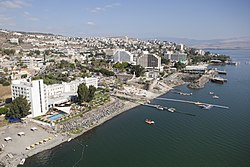
Back Tiberias Afrikaans Tiberias ALS طبريا Arabic طبريا ARZ Tiberiya Azerbaijani Тиберия Bulgarian তিবিরিয়া Bengali/Bangla Tiberias Breton Tiberíades Catalan Tiberias CEB
Tiberias
| |
|---|---|
City (from 1948) | |
| Hebrew transcription(s) | |
| • Also spelled | Tveria, Tveriah (unofficial) |
 | |
| Coordinates: 32°47′40″N 35°32′00″E / 32.79444°N 35.53333°E | |
| Grid position | 201/243 PAL |
| Country | |
| District | Northern |
| Founded | 1200 BCE (Biblical Rakkath) 20 CE (Herodian city) |
| Government | |
| • Mayor | Yossi Naba’a[1] |
| Area | |
• Total | 10,872 dunams (10.872 km2 or 4.198 sq mi) |
| Population (2023)[2] | |
• Total | 48,472 |
| • Density | 4,500/km2 (12,000/sq mi) |
| Ethnicity | |
| • Jews and others | 98.5% |
| • Arabs | 1.5% |
| Name meaning | City of Tiberius |
| Website | www.tiberias.muni.il |
Tiberias (/taɪˈbɪəriəs/ ty-BEER-ee-əs; Hebrew: טְבֶרְיָה, ⓘ; Arabic: طبريا, romanized: Ṭabariyyā)[3] is an Israeli city on the western shore of the Sea of Galilee. A major Jewish center during Late Antiquity, it has been considered since the 16th century one of Judaism's Four Holy Cities, along with Jerusalem, Hebron, and Safed.[4] In 2022, it had a population of 48,472.[2]
Tiberias was founded around 20 CE by Herod Antipas and was named after Roman emperor Tiberius.[5] It became a major political and religious hub of the Jews in the Land of Israel after the destruction of Jerusalem and the desolation of Judea during the Jewish–Roman wars. From the time of the second through the tenth centuries CE, Tiberias was the largest Jewish city in Galilee, and much of the Mishna and the Jerusalem Talmud were compiled there.[6] Tiberias flourished during the early Islamic period, when it served as the capital of Jund al-Urdunn and became a multi-cultural trading center.[5] The city slipped in importance following several earthquakes, foreign incursions, and after the Mamluks turned Safed into the capital of Galilee.[5] The city was greatly damaged by an earthquake in 1837, after which it was rebuilt, and it grew steadily following the First Jewish Aliyah in the 1880s.
In early modern times, Tiberias was a mixed city; under British rule it had a majority Jewish population, but with a significant Arab community. During the 1947–1948 civil war in Mandatory Palestine, fighting broke out between the Jewish residents of Tiberias and its Palestinian Arab minority. As the Haganah took over, British troops evacuated the entire Palestinian Arab population; they were refused reentry after the war, such that today the city has an almost exclusively Jewish population.[7][8] After the war ended, the new Israeli authorities destroyed the Old City of Tiberias.[9][8] A large number of Jewish immigrants to Israel subsequently settled in Tiberias.
Today, Tiberias is an important tourist center due to its proximity to the Sea of Galilee and religious sanctity to Judaism and Christianity. The city also serves as a regional industrial and commercial center. Its immediate neighbour to the south, Hammat Tiberias, which is now part of modern Tiberias, has been known for its hot springs, believed to cure skin and other ailments, for some two thousand years.[10]
- ^ "תוצאות הבחירות המקומיות 2024". TheMarker (in Hebrew). 3 March 2024. Retrieved 7 May 2024.
- ^ a b c "Regional Statistics". Israel Central Bureau of Statistics. Retrieved 21 March 2024.
- ^ "Definition of Tiberias | Dictionary.com". www.dictionary.com. Retrieved 11 May 2023.
- ^ "PALESTINE, HOLINESS OF". Jewish Encyclopedia. Archived from the original on 14 October 2011. Retrieved 21 September 2009.
- ^ a b c Hirschfeld, Y. (2007). Post-Roman Tiberias: between East and West. Post-Roman Towns, Trade and Settlement in Europe and Byzantium: Byzantium, Pliska, and the Balkans, 5, p. 193–204.
- ^ Conder and Kitchener 1881, SWP I, p. 419-420 "The Sanhedrim, after several removes, came to Tiberias about the middle of the second century, under the celebrated Rabbi Judah Hakkodesh, and from this time Tiberias became the central point of Jewish learning for several centuries. It was here that both the Mishna and the Gemara were compiled."
- ^ Abbasi, Mustafa (1 April 2008). "The end of Arab Tiberias: the Arabs of Tiberias and the Battle for the City in 1948". Journal of Palestine Studies. 37 (3). Informa UK Limited: 6–29. doi:10.1525/jps.2008.37.3.6. ISSN 0377-919X.
- ^ a b Rabinowitz, Dan; Monterescu, Daniel (1 May 2008). "Reconfiguring the "Mixed Town": Urban Transformations of Ethnonational Relations in Palestine and Israel". International Journal of Middle East Studies. 40 (2): 195–226. doi:10.1017/S0020743808080513. ISSN 1471-6380. S2CID 162633906.
The first mixed town forcibly emptied of its Palestinian residents was Tiberias, the 5,770 Palestinian inhabitants of which were driven out – mostly on buses – on 16 and 17 April 1948, when the town was taken by Jewish Hagana forces. ... In Tiberias, the demise of the Palestinian community was coupled in early 1949 with mass destruction of their old properties. By March the Israeli army had blown up and bulldozed 477 of the 696 buildings in the old city,&S
- ^ Abbasi, Mustafa (2008). "The War on the Mixed Cities: The Depopulation of Arab Tiberias and the Destruction of Its Old, 'Sacred' City (1948–9)". Holy Land Studies. 7 (1). Edinburgh University Press: 45–80. doi:10.3366/e1474947508000061. ISSN 1474-9475.
- ^ Patricia Erfurt-Cooper; Malcolm Cooper (27 July 2009). Health and Wellness Tourism: Spas and Hot Springs. Channel View Publications. p. 78. ISBN 978-1-84541-363-7. Archived from the original on 6 May 2016. Retrieved 29 October 2015.


